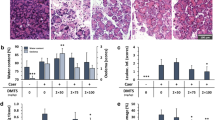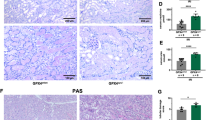Abstract
Acute pancreatitis (AP) is a common and devastating inflammatory condition of the pancreas that is considered to be a paradigm of sterile inflammation leading to systemic multiple organ dysfunction syndrome (MODS) and death1,2. Acute mortality from AP-MODS exceeds 20% (ref. 3), and the lifespans of those who survive the initial episode are typically shorter than those of the general population4. There are no specific therapies available to protect individuals from AP-MODS. Here we show that kynurenine-3-monooxygenase (KMO), a key enzyme of tryptophan metabolism5, is central to the pathogenesis of AP-MODS. We created a mouse strain that is deficient for Kmo (encoding KMO) and that has a robust biochemical phenotype that protects against extrapancreatic tissue injury to the lung, kidney and liver in experimental AP-MODS. A medicinal chemistry strategy based on modifications of the kynurenine substrate led to the discovery of the oxazolidinone GSK180 as a potent and specific inhibitor of KMO. The binding mode of the inhibitor in the active site was confirmed by X-ray co-crystallography at 3.2 Å resolution. Treatment with GSK180 resulted in rapid changes in the levels of kynurenine pathway metabolites in vivo, and it afforded therapeutic protection against MODS in a rat model of AP. Our findings establish KMO inhibition as a novel therapeutic strategy in the treatment of AP-MODS, and they open up a new area for drug discovery in critical illness.
This is a preview of subscription content, access via your institution
Access options
Subscribe to this journal
Receive 12 print issues and online access
$209.00 per year
only $17.42 per issue
Buy this article
- Purchase on Springer Link
- Instant access to full article PDF
Prices may be subject to local taxes which are calculated during checkout




Similar content being viewed by others
References
Lowenfels, A.B., Maisonneuve, P. & Sullivan, T. The changing character of acute pancreatitis: epidemiology, etiology, and prognosis. Curr. Gastroenterol. Rep. 11, 97–103 (2009).
Pastor, C.M., Matthay, M.A. & Frossard, J.L. Pancreatitis-associated acute lung injury: new insights. Chest 124, 2341–2351 (2003).
McKay, C.J. & Buter, A. Natural history of organ failure in acute pancreatitis. Pancreatology 3, 111–114 (2003).
Skouras, C. et al. Early organ dysfunction affects long-term survival in acute pancreatitis patients. HPB (Oxford) (2014).
Vécsei, L., Szalárdy, L., Fülöp, F. & Toldi, J. Kynurenines in the CNS: recent advances and new questions. Nat. Rev. Drug Discov. 12, 64–82 (2013).
Mole, D.J. et al. Tryptophan catabolites in mesenteric lymph may contribute to pancreatitis-associated organ failure. Br. J. Surg. 95, 855–867 (2008).
Mole, D.J., Olabi, B., Robinson, V., Garden, O.J. & Parks, R.W. Incidence of individual organ dysfunction in fatal acute pancreatitis: analysis of 1024 death records. HPB (Oxford) 11, 166–170 (2009).
Zwilling, D. et al. Kynurenine 3-monooxygenase inhibition in blood ameliorates neurodegeneration. Cell 145, 863–874 (2011).
Nakagami, Y., Saito, H. & Katsuki, H. 3-Hydroxykynurenine toxicity on the rat striatum in vivo. Jpn. J. Pharmacol. 71, 183–186 (1996).
Zhang, H. et al. IL-6 trans-signaling promotes pancreatitis-associated lung injury and lethality. J. Clin. Invest. 123, 1019–1031 (2013).
Courtney, S. & Scheel, A. Modulation of the kynurenine pathway for the potential treatment of neurodegenerative diseases. Curr. Top. Med. Chem. 6, 149–176 (2010).
Lowe, D.M. et al. Lead discovery for human kynurenine 3-monooxygenase by high-throughput RapidFire mass spectrometry. J. Biomol. Screen. 19, 508–515 (2014).
Amaral, M. et al. Structural basis of kynurenine 3-monooxygenase inhibition. Nature 496, 382–385 (2013).
McArthur, J.N. & Dawkins, P.D. The effect of sodium salicylate on the binding of L-tryptophan to serum proteins. J. Pharm. Pharmacol. 21, 744–750 (1969).
Sato, H. et al. KL-6 levels are elevated in plasma from patients with acute respiratory distress syndrome. Eur. Respir. J. 23, 142–145 (2004).
Nathani, N. et al. Kerbs von Lungren 6 antigen is a marker of alveolar inflammation but not of infection in patients with acute respiratory distress syndrome. Crit. Care 12, R12 (2008).
Kipari, T. et al. Nitric oxide is an important mediator of renal tubular epithelial cell death in vitro and in murine experimental hydronephrosis. Am. J. Pathol. 169, 388–399 (2006).
Lögters, T.T. et al. Increased plasma kynurenine values and kynurenine-tryptophan ratios after major trauma are early indicators for the development of sepsis. Shock 32, 29–34 (2009).
Pellegrin, K. et al. Enhanced enzymatic degradation of tryptophan by indoleamine 2,3-dioxygenase contributes to the tryptophan-deficient state seen after major trauma. Shock 23, 209–215 (2005).
Forrest, C.M. et al. Kynurenine metabolism predicts cognitive function in patients following cardiac bypass and thoracic surgery. J. Neurochem. 119, 136–152 (2011).
Wang, Y. et al. Kynurenine is an endothelium-derived relaxing factor produced during inflammation. Nat. Med. 16, 279–285 (2010).
Pawlak, K., Domaniewski, T., Mysliwiec, M. & Pawlak, D. The kynurenines are associated with oxidative stress, inflammation and the prevalence of cardiovascular disease in patients with end-stage renal disease. Atherosclerosis 204, 309–314 (2009).
Wang, Q. et al. Activation of NAD(P)H oxidase by tryptophan-derived 3-hydroxykynurenine accelerates endothelial apoptosis and dysfunction in vivo. Circ. Res. 114, 480–492 (2014).
Eastman, C.L. & Guilarte, T.R. The role of hydrogen peroxide in the in vitro cytotoxicity of 3-hydroxykynurenine. Neurochem. Res. 15, 1101–1107 (1990).
Okuda, S., Nishiyama, N., Saito, H. & Katsuki, H. Hydrogen peroxide-mediated neuronal cell death induced by an endogenous neurotoxin, 3-hydroxykynurenine. Proc. Natl. Acad. Sci. USA 93, 12553–12558 (1996).
Okuda, S., Nishiyama, N., Saito, H. & Katsuki, H. 3-Hydroxykynurenine, an endogenous oxidative stress generator, causes neuronal cell death with apoptotic features and region selectivity. J. Neurochem. 70, 299–307 (1998).
Giles, G.I., Collins, C.A., Stone, T.W. & Jacob, C. Electrochemical and in vitro evaluation of the redox-properties of kynurenine species. Biochem. Biophys. Res. Commun. 300, 719–724 (2003).
Wang, J. et al. Kynurenic acid as a ligand for orphan G protein-coupled receptor GPR35. J. Biol. Chem. 281, 22021–22028 (2006).
Moroni, F., Cozzi, A., Sili, M. & Mannaioni, G. Kynurenic acid: a metabolite with multiple actions and multiple targets in brain and periphery. J. Neural Transm. 119, 133–139 (2012).
Murakami, Y. & Saito, K. Species and cell types difference in tryptophan metabolism. Int. J. Tryptophan Res. 6 (suppl. 1), 47–54 (2013).
Bessede, A. et al. Aryl hydrocarbon receptor control of a disease tolerance defence pathway. Nature 511, 184–190 (2014).
von Bubnoff, D. et al. FcepsilonRI induces the tryptophan degradation pathway involved in regulating T cell responses. J. Immunol. 169, 1810–1816 (2002).
Chiarugi, A., Calvani, M., Meli, E., Traggiai, E. & Moroni, F. Synthesis and release of neurotoxic kynurenine metabolites by human monocyte-derived macrophages. J. Neuroimmunol. 120, 190–198 (2001).
Jones, S.P. et al. Expression of the kynurenine pathway in human peripheral blood mononuclear cells: implications for inflammatory and neurodegenerative disease. PLoS ONE 10, e0131389 (2015).
Zunszain, P.A. et al. Interleukin-1β: a new regulator of the kynurenine pathway affecting human hippocampal neurogenesis. Neuropsychopharmacology 37, 939–949 (2012).
Nguyen, N.T. et al. Aryl hydrocarbon receptor negatively regulates dendritic cell immunogenicity via a kynurenine-dependent mechanism. Proc. Natl. Acad. Sci. USA 107, 19961–19966 (2010).
Mezrich, J.D. et al. An interaction between kynurenine and the aryl hydrocarbon receptor can generate regulatory T cells. J. Immunol. 185, 3190–3198 (2010).
Opitz, C.A. et al. An endogenous tumour-promoting ligand of the human aryl hydrocarbon receptor. Nature 478, 197–203 (2011).
Genestet, C. et al. Scavenging of reactive oxygen species by tryptophan metabolites helps Pseudomonas aeruginosa escape neutrophil killing. Free Radic. Biol. Med. 73, 400–410 (2014).
Giorgini, F. et al. Targeted deletion of kynurenine 3-monooxygenase in mice: a new tool for studying kynurenine pathway metabolism in periphery and brain. J. Biol. Chem. 288, 36554–36566 (2013).
Laukkarinen, J.M., Van Acker, G.J., Weiss, E.R., Steer, M.L. & Perides, G. A mouse model of acute biliary pancreatitis induced by retrograde pancreatic duct infusion of Na-taurocholate. Gut 56, 1590–1598 (2007).
Mole, D.J., McFerran, N.V. & Diamond, T. Differential preservation of lipopolysaccharide-induced chemokine/cytokine expression during experimental pancreatitis-associated organ failure in rats shows a regulatory expressed phenotype. Pancreatology 8, 478–487 (2008).
Schmidt, J. et al. A better model of acute pancreatitis for evaluating therapy. Ann. Surg. 215, 44–56 (1992).
Mole, D.J., Taylor, M.A., McFerran, N.V. & Diamond, T. The isolated perfused liver response to a 'second hit' of portal endotoxin during severe acute pancreatitis. Pancreatology 5, 475–485 (2005).
Van Laethem, J.L. et al. Interleukin 10 prevents necrosis in murine experimental acute pancreatitis. Gastroenterology 108, 1917–1922 (1995).
Dragun, D. et al. FTY720-induced lymphocyte homing modulates post-transplant preservation/reperfusion injury. Kidney Int. 65, 1076–1083 (2004).
Studier, F.W. Protein production by auto-induction in high density shaking cultures. Protein Expr. Purif. 41, 207–234 (2005).
Wong, J., Ray, W.J. & Kornilova, A.Y. Development of a microplate fluorescence assay for kynurenine aminotransferase. Anal. Biochem. 409, 183–188 (2011).
Vonrhein, C. et al. Data processing and analysis with the autoPROC toolbox. Acta Crystallogr. D Biol. Crystallogr. 67, 293–302 (2011).
Kabsch, W. XDS. Acta Crystallogr. D Biol. Crystallogr. 66, 125–132 (2010).
Evans, P.R. & Murshudov, G.N. How good are my data and what is the resolution? Acta Crystallogr. D Biol. Crystallogr. 69, 1204–1214 (2013).
Winn, M.D. et al. Overview of the CCP4 suite and current developments. Acta Crystallogr. D Biol. Crystallogr. 67, 235–242 (2011).
Emsley, P., Lohkamp, B., Scott, W.G. & Cowtan, K. Features and development of Coot. Acta Crystallogr. D Biol. Crystallogr. 66, 486–501 (2010).
Acknowledgements
D.J.M. is supported by a Clinician Scientist Fellowship from the Health Foundation/Academy of Medical Sciences, the Medical Research Council Developmental Pathway Funding Stream and Wellcome Trust Institutional Strategic Support Fund. J.P.I. acknowledges the support of the Medical Research Council. We thank D. Harbison, Edinburgh Bioquarter, the staff of the Central Bioresearch Services, University of Edinburgh; F. Howie, D. Mauchline, M. McMillan, L. Boswell and M. Millar; and colleagues in the Medical Research Council Centre for Inflammation Research for support and advice.
Author information
Authors and Affiliations
Contributions
D.J.M., S.P.W., I.U. and J.L. led the University of Edinburgh/GlaxoSmithKline Discovery Partnership with Academia collaboration. D.J.M., S.P.W., I.U., O.J.G., J.P.H., S.E.M.H., D.S.H., J.L. and J.P.I. developed and refined the hypothesis and experimental design. D.J.M., X.Z., I.U., B.B., N.A., L.T. and V.B. did or designed the in vivo experiments. X.Z., M.G.F.S. and D.J.M. made the genetically altered mice from iKOMP embryonic stem cells. J.E.B. reported the pathology. S.P.W., I.U., J.L., M.B. and K.W. did or designed the cell-based experiments. N.Z.M.H., S.P.W. and M.B. did or developed the LC-MS/MS. J.P.H., C.H., J.L., S.P.W., D.J.M., A.M., I.U. and D.S.H. did or designed the assay development and screening. O.M., A.W., J.L., J.H. and D.S.H. did or designed the medicinal chemistry. P.R., C.G.M. and M.W. did the structural biology. All authors contributed to data analysis and/or interpretation. All authors contributed to, revised and approved the final version of the manuscript.
Corresponding author
Ethics declarations
Competing interests
The University of Edinburgh is engaged in a Discovery Partnership with Academia collaboration with GlaxoSmithKline. The University of Edinburgh receives milestone and royalty payments according to the phase of the project, as governed by the University of Edinburgh revenue sharing policy.
Supplementary information
Supplementary Text and Figures
Supplementary Figures 1–9, Supplementary Tables 1–5 and Supplementary Note (PDF 17975 kb)
Rights and permissions
About this article
Cite this article
Mole, D., Webster, S., Uings, I. et al. Kynurenine-3-monooxygenase inhibition prevents multiple organ failure in rodent models of acute pancreatitis. Nat Med 22, 202–209 (2016). https://doi.org/10.1038/nm.4020
Received:
Accepted:
Published:
Issue Date:
DOI: https://doi.org/10.1038/nm.4020
This article is cited by
-
Hypertriglyceridemia Acute Pancreatitis: Animal Experiment Research
Digestive Diseases and Sciences (2022)
-
Full-length in meso structure and mechanism of rat kynurenine 3-monooxygenase inhibition
Communications Biology (2021)
-
Apocynin Attenuates Acute Kidney Injury and Inflammation in Rats with Acute Hypertriglyceridemic Pancreatitis
Digestive Diseases and Sciences (2020)
-
Development and validation of three machine-learning models for predicting multiple organ failure in moderately severe and severe acute pancreatitis
BMC Gastroenterology (2019)
-
A brain-permeable inhibitor of the neurodegenerative disease target kynurenine 3-monooxygenase prevents accumulation of neurotoxic metabolites
Communications Biology (2019)



